SHADOWLAND® ‘Coast to Coast’
Hosta
Grow a Bit of Americana
- Striking foliage plant for shade
- Broad, puckered, wavy, golden yellow leaves
- Grows beautifully in large containers and landscapes
- Pale violet flowers appear in midsummer
- Attracts hummingbirds
- 30” tall x 36” spread
- Perennial in USDA Zones 3-9
- Pronounced “HAH-stuh”
When you plant ‘Coast to Coast’, you’re planting a bit of hosta royalty. This plant comes to us from multiple award winning hosta breeder Olga Petryszyn. As a daughter of Eastern European immigrants and a first generation American, Olga has worked passionately for over 30 years hybridizing giant hosta cultivars in her Indiana garden. ‘Coast to Coast’ is one of the most outstanding introductions from her “Americana Collection”.
What we love most about this stately gold hosta is its upright vase-like shape and the way its color transitions from chartreuse-yellow in spring to lighter gold in summer. While most gold hostas eventually turn green, ‘Coast to Coast’ maintains its yellow coloration through the entire season. Because when you plant something yellow, you want it to stay yellow, right?
how to grow shadowland® ‘COAST TO COAST’HOSTA
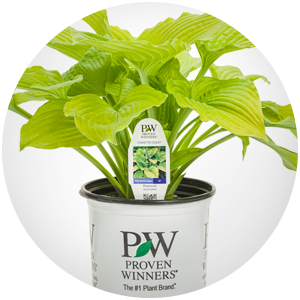
Planting
When choosing a spot to plant ‘Coast to Coast’, consider that it prefers to grow in morning sun or dappled sun throughout the day. Afternoon sun can be too strong and burn the foliage, especially in warm climates. Morning sun will draw out brighter yellow coloration in summer.
The first place you might consider planting your new hosta is under a tree. If the tree is deeply rooted, like an oak or hickory, there will be plenty of room for the hosta’s roots to grow. But maples, birches and spruce trees have broad, shallow root systems that could outcompete the hosta for root space. Consider root competition when finding the right spot.
‘Coast to Coast’ grows best in humus-rich soil that is moist and well-drained, but it will also grow reasonably well in sandy and clay soils. Use a good quality potting soil with a bit of slow release plant food mixed in if you plan to grow it in a container.
This hardy perennial isn’t too fussy about when you plant it. Cooler spring and fall weather is ideal, but if summer is your only option, just be sure to plant it in the shade and keep the soil moist through the warmest months while its roots get established.
When planting, dig the hole about twice as wide but just as deep as the container it is growing in. If your soil is light in color–indicating it doesn’t contain much organic matter–add several handfuls of humus, compost or aged manure when you backfill the hole. That will provide extra nutrients and water-holding capacity to the soil.
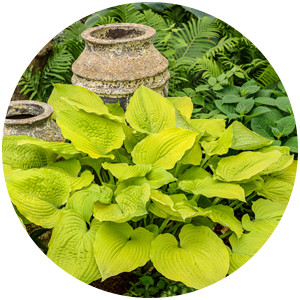
Maintenance
Hostas require very little maintenance during the growing season. They need little more than some shade, good soil and moisture to flourish all on their own.
Watch for rabbits in spring–this is their favorite time of year to munch on hostas. Just as their pointed tips emerge from the soil, a hungry bunny may come along and nip them off. It won’t hurt the hosta but once its leaves unfurl, you’ll see the bunny’s teeth marks. Avoid this by applying animal repellent on your hostas in early spring just as they start to come up.
If deer are an issue in your garden, consider growing more deer resistant plants or plan to protect your hostas with animal repellent or fencing. Taller, thinner leaved cultivars are more prone to damage simply because they are easier for the deer to eat.
During wet weather, slug populations can multiply quickly. If you start seeing holes in your hosta leaves, it’s a sure sign that they have moved in. Here is an article to help you “slug it out” with these pesky creatures.
Hostas should be cut back in fall once their foliage has gone to sleep for the season. Remove the spent foliage from the garden bed and dispose of it to help avoid future slug damage around the plants.
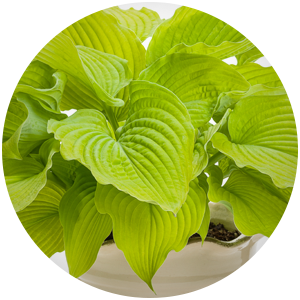
Companion plants
The broad textured foliage of ‘Coast to Coast’ contrasts beautifully with shade loving perennials that have lacy leaves like ferns, goatsbeard, astilbe and strappy leaved sedges. Its bright tones are easily complemented with brightly colored Dolce® and Primo® Heuchera or the fluffy blossoms of bee balm.
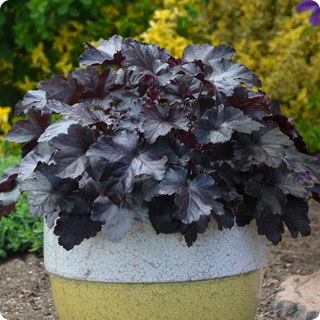
Primo® ‘Black Pearl’ Heuchera
When pairing your hostas with other plants, look for those that prefer similar cultural conditions, including a preference for shade and rich, moist soil. Your local garden center likely has a separate section for shade perennials where you’ll find all sorts of companions for ‘Coast to Coast’.
Wine Tour Recipe
Shadowland® ‘Coast to Coast’ Hosta
Primo® ‘Mahogany Monster’ Coral Bells Heuchera
Dolce® ‘Apple Twist’ Coral Bells Heuchera
Exposure
Part shade-shade
Season
Early Spring
Spring
Summer
Fall
Container Size
14 Inches
Click the plant names for more info
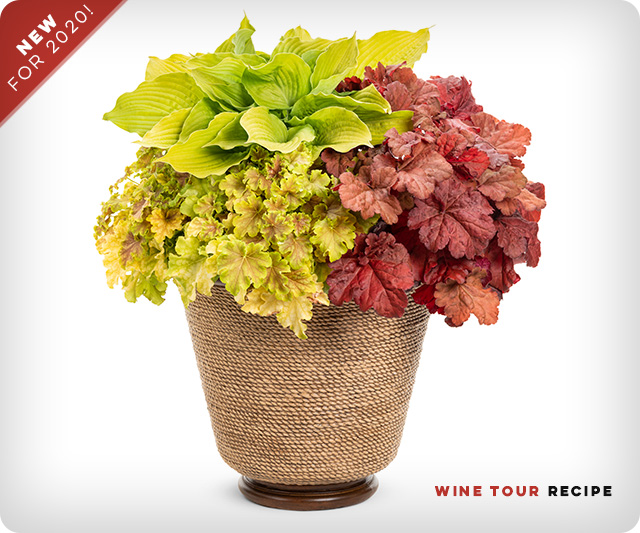
top 3 reasons to
grow ‘Coast to Coast’ Hosta
IT PROVIDES A GLORIOUS BACKDROP FOR OTHER PLANTS
Though it has a magic all its own, this giant gold hosta sets the stage for the smaller, colorful flowers and perennials you will plant at its feet.
IT’S SUPER COLD HARDY
Hardy down to -40°F, you will never have to worry about this perennial returning reliably every year.
IT WILL THRIVE IN YOUR SHADIEST PLACES
While many showy perennials need full sun to thrive, ‘Coast to Coast’ will happily light up your shade garden with its glowing hues.
Shadowland® ‘Coast to Coast’ Hosta USPP26469 Can5335
